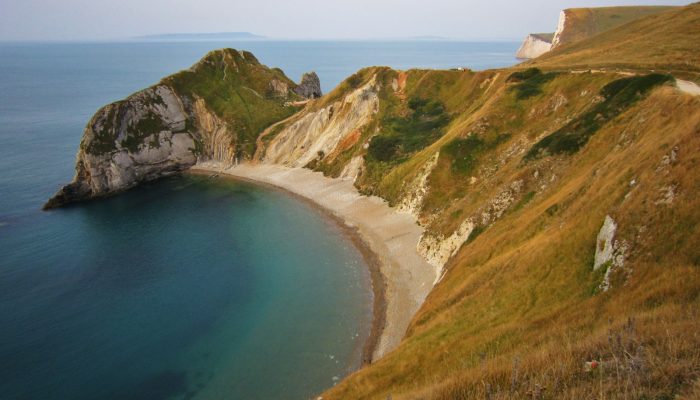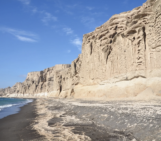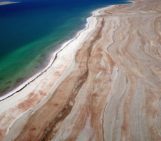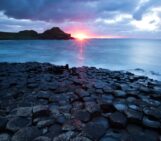
Did you know that the shape of coastlines is determined by the angle at which waves crash against the shoreline. It has long been thought that fluctuations in the wave incidence angle are rapidly felt by coastlines, which change the shapes of their shores quickly in response to shifting wave patterns.
Or do they?
Researchers at the British Geological Survey, Duke University (USA) and Woods Hole Oceanographic Institution in Massachusetts, have performed experiments which show that spits and capes hold ‘a memory’ of their former shapes and past wave climates, influencing their present geomorphology. The findings have recently been published in the EGU’s open access journal Earth Surface Dynamics.
Gradients in sediment distribution within wave-driven currents and shoreface depth play an important role in shaping coastlines. But the angle between an offshore wave crest and the shoreline is chief among the parameters which shape coasts worldwide.
Low-angle waves – those with approach the coast at an angle of 45° or less – have a smoothing effect on the coastline and keep its shape relatively steady. On the other hand, high-angle waves – those with slam against the shore at an angle of 45° or more – introduce instability and perturbations which shape the coast.

The figure shows the experimental set-up used in the study. It also nicely illustrates how coastlines are shaped by the angle of the incoming wave. The arrows indicatenet flux direction under waves incoming from the left; arrow lengths qualitatively indicate the flux. Sand is not transported through cells which are in shadow for a particular wave. From C. W. Thomas et al., 2016.
Alterations to the patterns of shorelines are caused by enhanced erosion and/or deposition, driven by changes in wave climate. Ultimately, coastline geomorphology evolves depending on the relative degree of high and low-angle waves in the wave climate, as well as the degree of irregularity in the wave angle distribution.
Climate change will alter the wave climate, particularly during storm events, so we can expect shorelines to shift globally. Predicting how coastlines will adapt to changing climatic conditions is hard, but more so if coastlines retain a memory of their past shapes when responding to changing wave regimes.
Flying spits (finger-like landforms which project out towards sea from relatively straight shoreline) and cuspate capes (a triangular shaped accumulation of sand and shingle which grows out towards sea) are particularly susceptible to climate change. They form when high angle waves approach the shore at a slant. Animal communities living within fragile marine and estuarine ecosystems largely depend on the protection they offer. They are also of socio-economic importance as many shelter coastal infrastructures. Understanding how they will be affected by a changing climate is vital to develop well-informed coastal management policies.
To understand how changing wave climates affect the evolution of flying spits and cuspate capes (from now on referred to as spits and capes), the team of researchers devised experiments which ran on a computer simulation.
They generated an initially straight shoreline and set the wave conditions for the next 250 years (which is the length of time it takes in nature) to allow the formation of spits and capes.
To test whether pre-existing coastal morphologies played a role in shaping coastlines under changing wave climates, over a period of 100 years (which is loosely the rate at which climate change is thought to be occurring under anthropogenic influences), the scientists gradually changed the angle at which waves approached the coast. After the 100 year period the simulation was left to run a further 650 years under the new wave conditions.
The investigation revealed that when subjected to gradual changes in the angle at which waves approach the shoreline, capes take about 100 years to start displaying a new morphology. The tips of the capes are eroded away and so they slowly start to shrink.
Spits adjust to change much more slowly. Even after 750 years the experimental coastlines retain significant undulations, suggesting that sandy spits retain a long-term memory of their former shape.

Snapshots of simulated coastline morphologies evolved under changing wave climate. U is the fraction of waves which are approaching the shoreline at 45 degress or higher. Coastlines evolved for 250 years under initial conditions. (aii, bii)> The U values of the changed wave climate show the coastline morphologies evolved 200 and 500 years after the wave climate is changed at 250 years, and the morphologies evolved over 1000 years under static wave climates with the same U. From C. W. Thomas et al., 2016. See paper for full image caption. Click to enlarge.
The implications of the results are far reaching.
Be it implicitly or explicitly, many studies of coastal geomorphology assume that present coastal shape is exclusively a result of present wave climate. The new study shows that even with steady wave climate conditions at present, coastline shapes could still be responding to a past change in wave climate.
Reconstructions of ancient coastal geographies and paleo-wave climates might also be approached differently from now on. The researchers found that as spits adjust to changing wave climates they can leave behind a complex array of lagoons linked by beach bridges. Though there are a number of process which can lead to the formation of these coastal features, researchers must also consider alterations of coastlines as a response to changing wave climate from now on.
The findings of the study can also be applied to the management of sandy coastlines.
Currently, forecasts of future shoreline erosion and sediment deposition are made based on observations of how coasts have changed in recent decades. The new study highlights these short observation timescales may not be enough to fully appreciate how our beaches and coasts might be reshaped in the future.
This is especially true when it comes to climate change mitigation. Decisions on how to best protect the world’s shores based on their environmental and socio-economic importance will greatly benefit from long-term monitoring of coastal geomorphology.
But more work is needed too. The experiments performed by the team only consider two types of coastline morphology (spits and capes) and only two types of wave climate. While the experiments provide a time-scale over which spits and capes might be expected to change, other factors not considered in the study (wave height, shoreface depth, etc…) will alter the predicted timescales. The time-scales given by the study should be used only as a guideline and highlight the need for more research in this area.
By Laura Roberts Artal, EGU Communications Officer
References
Thomas, C. W., Murray, A. B., Ashton, A. D., Hurst, M. D., Barkwith, A. K. A. P., and Ellis, M. A.: Complex coastlines responding to climate change: do shoreline shapes reflect present forcing or “remember” the distant past?, Earth Surf. Dynam., 4, 871-884, doi:10.5194/esurf-4-871-2016, 2016.




